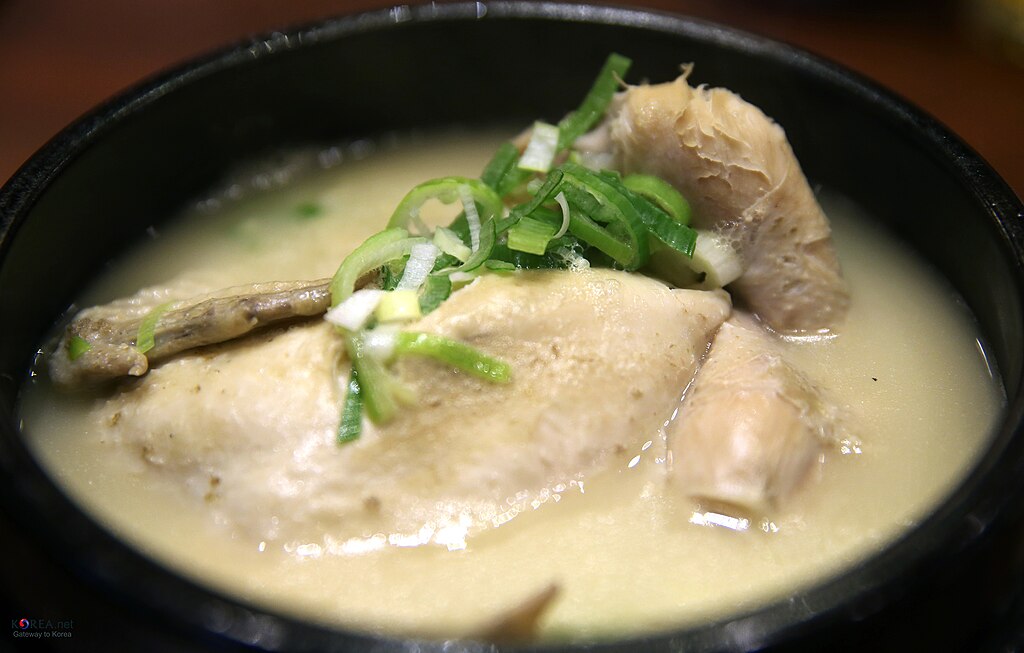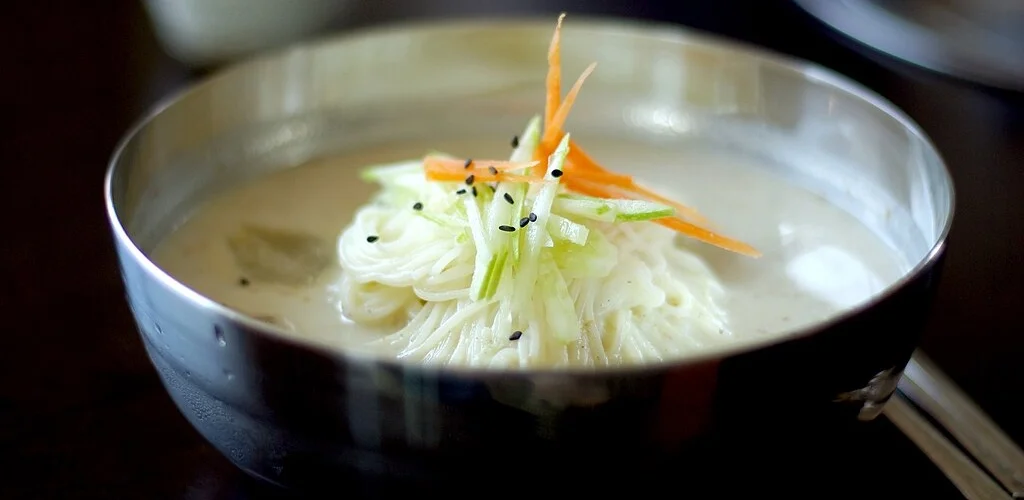Beat the Heat: 7 Lesser-Known Korean Summer Foods You Need to Try
When the scorching Korean summer hits and you start losing a gallon of sweat every day, you can turn to the traditional knowledge hidden in regional Korean cuisine to keep you cool through the hottest days of the year. Get ready to discover how Korea’s regional food traditions turn summer heat into deliciousness through the fascinating philosophy of iyeolchiyeol ( 이열치열) - literally “fighting fire with fire.”

Ministry of Culture, Sports and Tourism Korean Culture and Information Service Korea.net(www.korea.net) JEON HAN
While you might know naengmyeon, bingsu, or samgyetang, we’re diving deep into Korea’s lesser-known regional summer specialties that showcase the incredible diversity of Korean cuisine. From Jeolla Province’s soul-warming kongguksu to the refreshing simplicity of oi naengguk, these dishes represent centuries of Korean wisdom about staying healthy and energized during the hottest months of the year.
The Philosophy Behind Korean Summer Eating
Korean summer food culture centers on iyeolchiyeol (이열치열), an ancient concept meaning “expel heat with heat.” This isn’t just folk wisdom—it’s rooted in traditional Korean medicine’s understanding that when your body works to cool itself externally through sweating, your internal organs may actually become cooler and need warming foods to maintain proper digestive function.
This philosophy reaches its peak during sambok (삼복), the three hottest days of summer: chobok (초복), jungbok ( 중복), and malbok (말복). During these periods, families gather to consume boyangshik (보양식) - invigorating foods designed to restore depleted energy and strengthen the body for the demanding harvest season ahead.
1. Kongguksu (콩국수) - Jeolla Province’s Creamy Summer Soul Food
If there’s one dish that perfectly embodies Korea’s regional summer food mastery, it’s kongguksu (콩국수) from Jeolla Province. This isn’t your typical cold noodle soup - it’s a creamy, protein-rich bowl of comfort that showcases why Jeolla is considered Korea’s culinary capital.
Traditional kongguksu starts with dried soybeans soaked overnight, then ground by hand with the skin left on. This creates a naturally creamy, slightly grainy broth that is worlds apart from the smooth commercial versions you might find elsewhere. The broth gets seasoned with just salt - no fancy additions needed when you’re working with premium ingredients.
The noodles matter too. Hand-cut somyeon (소면) wheat noodles provide the perfect chewy texture to contrast with the silky broth. Usually topped with paper-thin cucumber julienne and a sprinkle of toasted sesame seeds, kongguksu is a dish that’s simultaneously refreshing and deeply satisfying.
Why it works for summer: The high protein content helps maintain energy levels during heat-sapping summer days, while the cold temperature provides immediate cooling relief. The soybeans contain natural compounds that aid digestion - crucial when appetite often wanes in extreme heat.
Recipe Link: Authentic Kongguksu Recipe - Korean Bapsang

2. Oi Naengguk (오이냉국) - The Ultimate Refreshing Soup
There’s something magical about oi naengguk (오이냉국) that takes you straight back to Korean childhood summers. This chilled cucumber soup represents the genius of Korean home cooking - taking simple, seasonal ingredients and transforming them into something that’s both deeply satisfying and incredibly refreshing.
The base is a tangy, slightly sweet broth made with rice vinegar, a touch of sugar, and salt. Paper-thin cucumber slices get added along with rehydrated miyeok ( 미역, dried seaweed), creating a textural symphony of crunch and chew. Some families add thinly sliced onions or radish for extra bite, while others keep it pure and simple.
What makes this soup special is the balance - the acidity cuts through summer sluggishness, the cucumber provides cooling hydration, and the seaweed adds minerals lost through sweating. It’s often served as a palate cleanser during multi-course summer meals, but it’s substantial enough to be a light meal on its own with some rice.
Pro tip: The cucumber variety matters. Korean oi (오이) cucumbers are smaller, thinner-skinned, and more flavorful than Western varieties. If you can’t find them, Persian or Japanese cucumbers work better than standard English cucumbers.
Recipe Link: Traditional Oi Naengguk - Korean Bapsang
3. Jinju-Style Naengmyeon (진주냉면) - Coastal Korea’s Hidden Gem
While most people know Pyongyang or Hamhung-style naengmyeon, Jinju-style naengmyeon (진주냉면) from South Gyeongsang Province represents one of Korea’s best-kept regional secrets. This coastal variation showcases the sophisticated seafood-based broths that make Korean regional cuisine so fascinating.
The broth starts with dried pollock, kelp, dried shrimp, and mussels, slowly simmered to extract maximum umami. Unlike the stark, clear broths of northern-style naengmyeon, Jinju naengmyeon has a more complex, sea-forward flavor profile that reflects its coastal origins.
The signature garnish is yukjeon (육전) - thin slices of beef that have been dredged in flour and egg, then pan-fried until golden. These protein-rich additions make Jinju naengmyeon more substantial than other regional variations, reflecting the hearty eating traditions of Korea’s southeastern coastal regions.
Cultural context: Jinju was historically an important regional administrative center, and this style of naengmyeon reflects the area’s prosperity and access to both mountain and sea ingredients. The dish represents the sophisticated regional cuisine that developed in Korea’s provincial capitals.
4. Sikhye (식혜) - The Ancient Probiotic Drink
Long before kombucha became trendy, Korea had sikhye (식혜) - a naturally fermented rice drink that perfectly embodies Korean food wisdom about digestive health and seasonal eating. This sweet, slightly tangy beverage with floating rice grains might look unusual to newcomers, but it’s been a beloved summer staple for over a thousand years.
Traditional sikhye starts with yeot-gireum (엿기름, malted barley), which contains natural enzymes that break down rice starches into sugars. Cooked rice gets added to the malted barley water and fermented for several hours, creating a naturally sweet drink with beneficial enzymes intact.
The magic happens in the fermentation - the enzymes not only create the characteristic sweetness but also aid digestion, making sikhye the perfect end to heavy sambok meals. The floating rice grains add texture and contribute to the drink feeling more substantial than typical beverages.
Modern relevance: Korean families often serve sikhye after barbecue meals or during festival celebrations. It’s particularly popular during Chuseok (추석, Korean Thanksgiving) but makes an excellent summer digestif when served ice-cold.
Health benefits: The natural fermentation process creates beneficial enzymes that support digestion, while the rice provides easily digestible carbohydrates for quick energy restoration.
5. Sujeonggwa (수정과) - Royal Court’s Summer Elixir
Sujeonggwa (수정과) represents the elegant side of Korean traditional beverages - a spiced persimmon and cinnamon drink that originated in Korean royal courts and embodies the sophisticated flavor combinations that characterize Korean traditional cuisine.
This amber-colored drink combines dried persimmons, cinnamon sticks, ginger, and pine nuts in a complex brewing process that can take several hours. The result is a naturally sweet, warming drink with layers of flavor that unfold as you sip. Despite being served cold in summer, the warming spices align with iyeolchiyeol principles.
Traditional preparation involves simmering cinnamon bark and ginger to create a fragrant base, then adding dried persimmons for natural sweetness. The drink gets chilled and garnished with pine nuts, creating an elegant presentation worthy of its royal heritage.
Cultural significance: Sujeonggwa appears in historical records from the Goryeo Dynasty (918-1392) and was considered a medicinal drink in traditional Korean medicine. The cinnamon aids circulation, ginger supports digestion, and persimmons provide vitamins and minerals.
Recipe Link: Traditional Sujeonggwa Recipe - Maangchi
6. Gaji Namul (가지나물) - Purple Summer Banchan
Korean summer banchan (side dishes) go far beyond kimchi, and gaji namul (가지나물) showcases the seasonal vegetable preparations that make Korean home cooking so diverse. This steamed eggplant banchan captures the essence of Korean vegetable cookery—simple preparation that highlights natural flavors and textures.
Korean eggplants are smaller and more tender than Mediterranean varieties, with thin, edible skin that takes on a beautiful purple hue when steamed. The eggplant gets steamed until silky, then seasoned with sesame oil, minced garlic, salt, and a touch of soy sauce. Some regions add finely chopped scallions or perilla leaves for extra flavor complexity.
The beauty of gaji namul lies in its simplicity - it’s all about the quality of the eggplant and the balance of seasonings. When done right, it’s silky, savory, and subtly nutty from the sesame oil, with the eggplant’s natural sweetness shining through.
Seasonal significance: Eggplants peak in Korean summer months, and this preparation method preserves their delicate texture while creating a cooling banchan that pairs perfectly with heavier summer proteins.
7. Mul-naengmyeon Variations (물냉면) - Regional Cold Noodle Mastery
While mul-naengmyeon (물냉면, water cold noodles) might seem familiar, Korea’s regional variations reveal incredible diversity in this seemingly simple dish. Each region’s approach reflects local ingredients, climate, and cultural preferences, creating a fascinating map of Korean regional cuisine.
Busan-style features a seafood-forward broth with subtle ocean flavors, reflecting the port city’s maritime culture. Jeju Island versions incorporate local black pork and unique island vegetables. Gangwon Province maintains mountain-influenced preparations with wild vegetables and pure spring water bases.
The noodle composition also varies - some regions favor higher buckwheat content for nuttier flavor, while others adjust the sweet potato starch ratio for different textures. Even the garnish arrangements follow regional patterns, with coastal areas favoring seafood additions and mountain regions highlighting foraged vegetables.
What to look for: Authentic regional naengmyeon restaurants often display their hometown prominently. The broth clarity, noodle texture, and garnish combinations will give you clues about the regional style being served.
Where to Experience These Dishes
In Korea:
- Seoul’s Tosokchon (토속촌) near Gyeongbokgung Palace for traditional sambok dining (reservations required during peak season)
- Jeonju’s Hanguk-jip (한국집) for authentic Jeolla-style kongguksu
- Jinju’s traditional markets for regional naengmyeon specialties
Making at Home: Most of these dishes are surprisingly accessible for home cooking. Korean grocery stores worldwide stock the essential ingredients, and many recipes scale well for family meals.
Recipe Resources:
- Korean Bapsang for family-tested traditional recipes
- Maangchi for video tutorials and cultural context
- Local Korean cultural centers often offer cooking classes featuring seasonal dishes
Embracing Korean Summer Food Wisdom
Korean summer food culture offers something profound that goes beyond just beating the heat - it’s about understanding how food connects to seasons, health, and community. The philosophy of iyeolchiyeol teaches us to work with natural processes rather than against them, while regional specialties remind us that Korean cuisine extends far beyond Seoul’s restaurants.
These seven dishes represent just a glimpse into Korea’s vast regional summer food traditions. Each one carries centuries of accumulated wisdom about staying healthy, energized, and connected to seasonal rhythms. Whether you’re slurping kongguksu on a sweltering afternoon or sharing sujeonggwa with friends, you’re participating in food traditions that have sustained Korean communities through countless summers.
Sources
- Korean Cultural Center. “Traditional Korean Summer Foods and Sambok Culture.” Korea.net, 2023.
- Journal of Ethnic Foods. “Regional Variations in Korean Cold Noodle Preparations.” BioMed Central, 2022.
- Lee, Min-jung. “Seasonal Eating Practices in Korean Traditional Medicine.” Korean Food Research Institute, 2023.
- Park, Soo-jin. “Fermented Beverages in Korean Food Culture.” Traditional Food Studies Quarterly, 2022.
- Choi, Young-ho. “Regional Cuisines of Jeolla Province.” Amazing Food and Drink, 2023.
See also
- Ahjussi Taste: Best Traditional Korean Foods (아저씨 입맛)
- Food survival vocabulary in Korean (necessary vocabulary to order food in restaurants)
- A dialogue between two friends and a waiter at a restaurant (booking a table, ordering food, paying)